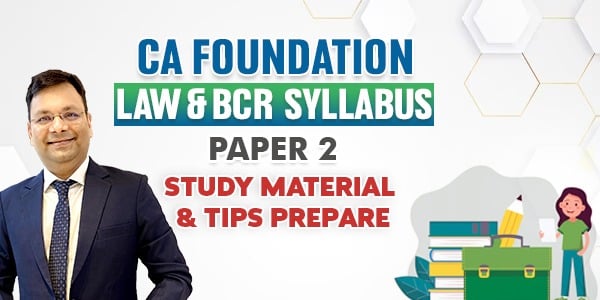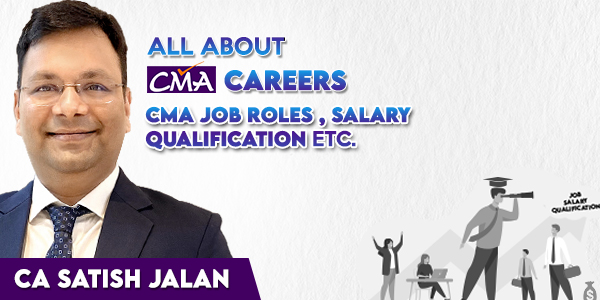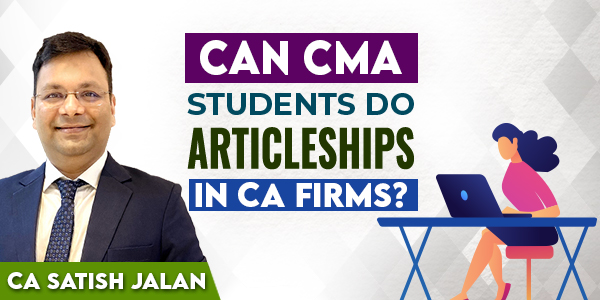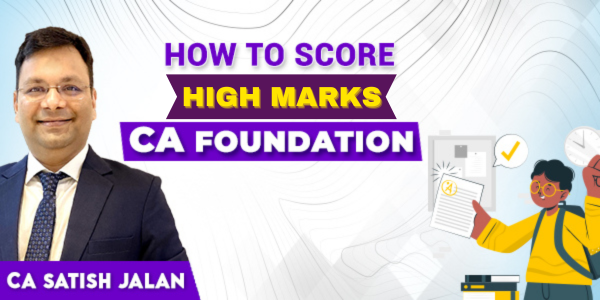09
Oct, 2023
CA Foundation Law & BCR( Paper 2) - Paper Pattern, Study Material, How to Prepare.
-
CA Foundation, CA
CA Satish Jalan
CA Foundation Law & BCR is the second paper in the CA Foundation course. Paper 2 covers Business Law and Business Correspondence and Reporting. This paper aims to develop an understanding of several business laws. It helps in the growth of analytical skills required to tackle real-life problems.
This blog will help you to know CA Foundation law & BCR study material, curriculum, paper pattern, weightage, MTPs, RTPs, previous year's question papers, ABC analysis, and case studies.
CA Foundation Paper Pattern for Law & BCR
Paper pattern: Subjective
The total number of questions is 100.
Total exam time: 2 hours
Total Marks: 100 marks (60 marks for Business Law, 40 marks for business correspondence and reporting)
Study Material of CA Foundation Law & BCR ( Paper 2 )
As we know, Paper 2 is divided into two sections i.e.
Section B: Business Correspondence & Reporting
Amendments applicable for Dec 2023 Exams
CA Foundation Law & BCR Previous Year Question Papers
|
Question Papers |
Download |
|
June 2023 |
Download |
|
Dec 2022 |
|
|
June 2022 |
|
|
Dec 2021 |
|
|
June 2021 |
CA Foundation Law & BCR Mock Test Papers
|
Dec 2023 - Series 1 |
Question Paper - To be released soon |
Answer |
|
Dec 2023 - Series 2 |
Question Paper- to be released soon |
Answer |
|
June 2023 - Series 1 |
||
|
June 2023- Series 2 |
How to prepare for the CA Foundation Law & BCR Paper?
To thrive in Business Law and achieve high marks, you can use a planned approach that combines effective study approaches and exam preparation.
Comprehensive Notes: Use notes that cover the entire syllabus in clear, easy-to-understand language.
Previous Exam Questions: Study previous exam questions to learn about the types of questions typically posed about each important law act.
Papers for Practice: Solve Revision Test Papers and Mock Test Papers to become acquainted with the exam format and to practise answering problems under time limitations.
Time Management: To strengthen your time management skills, time yourself throughout practice tests. Writing at least three full-length exam papers under scheduled settings will help you become acquainted with the exam.
Tips for Learning Law & BCR
Concentrate on Key Points: Take note of the key points in each answer and practise summarising them. This will assist you in remembering the key concepts more successfully.
Highlight Key Words: Identify and highlight keywords in your answers. Remember these terms since they will help you frame your responses correctly throughout the exam.
Use Law Language: When possible, add legal and technical terms to your answers. This suggests a thorough knowledge of the subject.
Section Numbers: Make a list of key law act section numbers and examine it on a regular basis. While quoting section numbers can improve your replies, only do so if you are certain of their accuracy. Section numbers that are incorrect should be avoided.
How to Make CA Foundation Law Summary Notes?
Well-structured manner:
Keep your law notes well-structured to promote efficient evaluation, especially during the revision phase. To organise distinct issues, use headings, clear bullet points, and subheadings. This approach not only improves the organisation of your notes but also makes it easier to find certain information.
Highlight Important Ideas:
Avoid the urge to note down everything while taking notes during lectures. Instead, focus on capturing significant concepts, noteworthy case studies, key definitions, and practical examples that will help you understand the subject better.
Actively Participate in Listening:
When attending business law CA Foundation and BCR lectures, try to actively participate in the listening process. Engage in discussions, ask questions, and seek clarification as needed. This proactive approach helps in determining the essential takeaways that should be included in your notes and improve your understanding of the subject matter.
Make Use of Visual Aids:
Visual aids make complex concepts easier to grasp and are extremely effective at improving your understanding of a variety of topics. Techniques like diagrams, flowcharts, and mind maps can help you make your notes more effective. Furthermore, these visual aids can act as mnemonic devices, assisting with information memory when needed.
Utilise Digital Tools:
To improve your note-taking process, consider incorporating digital note-taking tools and programs into your study regimen. These applications, including Evernote, Microsoft OneNote, and Google Keep, provide the flexibility to organise your notes properly in today's tech-savvy workplace. They let you access your notes from numerous devices and include features like highlighting, tagging, storing essential links, and organising photos by topic.
Popular Posts






No Comments